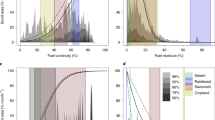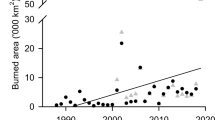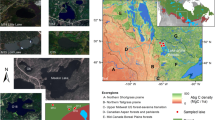Abstract
Large, well-documented wildfires have recently generated worldwide attention, and raised concerns about the impacts of humans and climate change on wildfire regimes. However, comparatively little is known about the patterns and driving forces of global fire activity before the twentieth century. Here we compile sedimentary charcoal records spanning six continents to document trends in both natural and anthropogenic biomass burning for the past two millennia. We find that global biomass burning declined from AD 1 to ∼1750, before rising sharply between 1750 and 1870. Global burning then declined abruptly after 1870. The early decline in biomass burning occurred in concert with a global cooling trend and despite a rise in the human population. We suggest the subsequent rise was linked to increasing human influences, such as population growth and land-use changes. Our compilation suggests that the final decline occurred despite increasing air temperatures and population. We attribute this reduction in the amount of biomass burned over the past 150 years to the global expansion of intensive grazing, agriculture and fire management.
This is a preview of subscription content, access via your institution
Access options
Subscribe to this journal
Receive 12 print issues and online access
$259.00 per year
only $21.58 per issue
Buy this article
- Purchase on Springer Link
- Instant access to full article PDF
Prices may be subject to local taxes which are calculated during checkout




Similar content being viewed by others
Change history
23 February 2009
In the version of this Article originally published, the y axis label of Fig. 4d was incorrect. This error has been corrected in the HTML and PDF versions.
References
Scott, A. C. The pre-quaternary history of fire. Palaeogeogr. Palaeoclimatol. Palaeoecol. 164, 281–329 (2000).
Bond, W. J. & Keeley, J. E. Fire as a global ‘herbivore’: The ecology and evolution of flammable ecosystems. Trends Ecol. Evol. 20, 387–394 (2005).
Scott, A. C. & Glasspool, I. J. The diversification of Paleozoic fire systems and fluctuations in atmospheric oxygen concentration. Proc. Natl Acad. Sci. USA 103, 10861–10865 (2006).
Westerling, A. L., Hidalgo, H. G., Cayan, D. R. & Swetnam, T. W. Warming and earlier spring increase western US forest wildfire activity. Science 313, 940–943 (2006).
Van der Werf, G. R., Randerson, J. T., Giglio, L., Collatz, G. J. & Kasibhatla, P. S. Interannual variability in global biomass burning emission from 1997 to 2004. Atmos. Chem. Phys. 6, 3423–3441 (2006).
Mouillot, F. & Field, C. B. Fire history and the global carbon budget: a 1∘×1∘ fire history reconstruction for the 20th century. Glob. Change Biol. 11, 398–420 (2005).
Swetnam, T. W. & Betancourt, J. L. Mesoscale disturbance and ecological response to decadal climatic variability in the American southwest. J. Clim. 11, 3128–3147 (1998).
Girardin, M. P. & Sauchyn, D. Three centuries of annual area burned variability in northwestern North America inferred from tree rings. Holocene 18, 205–214 (2008).
Carcaillet, C. et al. Holocene biomass burning and global dynamics of the carbon cycle. Chemosphere 49, 845–863 (2002).
Power, M. J. et al. Changes in fire regimes since the Last Glacial Maximum: An assessment based on a global synthesis and analysis of charcoal data. Clim. Dyn. 30, 887–907 (2008).
Marlon, J., Bartlein, P. J. & Whitlock, C. Fire-fuel-climate linkages in the northwestern USA during the Holocene. Holocene 16, 1059–1071 (2006).
Higuera, P. E., Peters, M. E., Brubaker, L. B. & Gavin, D. G. Understanding the origin and analysis of sediment-charcoal records with a simulation model. Quat. Sci. Rev. 26, 1790–1809 (2007).
Page, S. E. et al. The amount of carbon released from peat and forest fires in Indonesia during 1997. Nature 420, 61–65 (1997).
Cochrane, M. A. Fire science for rain forests. Nature 421, 913–919 (2003).
Anshari, G., Peter Kershaw, A. & van der Kaars, S. A Late Pleistocene and Holocene pollen and charcoal record from peat swamp forest, Lake Sentarum Wildlife Reserve, West Kalimantan, Indonesia. Palaeogeogr. Palaeoclimatol. Palaeoecol. 171, 213–228 (2001).
Millspaugh, S. H., Whitlock, C. & Bartlein, P. J. Variations in fire frequency and climate over the past 17000 yr in central Yellowstone National Park. Geology 28, 211–214 (2000).
Millspaugh, S. H., Whitlock, C. & Bartlein, P. in After the Fires: The Ecology of Change in Yellowstone National Park (ed. Wallace, L.) 10–28 (Yale Univ. Press, New Haven, 2004).
Jansen, E. et al. in Climate Change 2007: The Physical Science Basis. Contribution of Working Group I to the Fourth Assessment Report of the Intergovernmental Panel on Climate Change (eds Solomon, S. et al.) 433–497 (Cambridge Univ. Press, Cambridge, 2007).
Ammann, C. M., Joos, F., Schimel, D. S., Otto-Bliesner, B. L. & Tomas, R. A. Solar influence on climate during the past millennium: Results from transient simulations with the NCAR Climate System Model. Proc. Natl Acad. Sci. USA 104, 3713–3718 (2007).
Klein Goldewijk, K. & Ramankutty, N. Land cover change over the last three centuries due to human activities: The availability of new global data sets. Geojournal 61, 335–344 (2004).
Savage, M. & Swetnam, T. W. Early 19th-century fire decline following sheep pasturing in a Navajo ponderosa pine forest. Ecology 71, 2374–2378 (1990).
Swetnam, T. W. & Baisan, C. H. in Fire and Climate in Temperate Ecosystems of the Western Americas (eds Veblen, T. T., Baker, W. L., Montenegro, G. & Swetnam, T. W.) 158–195 (Springer, New York, 2003).
Pyne, S. J. World Fire: The Culture of Fire on Earth (Univ. of Washington Press, Seattle, 1995).
Chapin, F. S. III. et al. Role of land-surface changes in Arctic summer warming. Science 310, 657–660 (2005).
Girardin, M. P. Interannual to decadal changes in area burned in Canada from 1781 to 1982 and the relationship to Northern Hemisphere land temperatures. Glob. Ecol. Biogeog. 16, 557–566 (2007).
Ferretti, D. F. et al. Unexpected changes to the global methane budget over the past 2000 years. Science 309, 1714–1717 (2005).
Houweling, S., van der Werf, G, Klein Goldewijk, K., Röckmann, T. & Aben, I. Early anthropogenic emissions and the variation of CH4 and 13CH4 over the last millennium. Glob. Biogeochem. Cycles 22, GB1002doi:10.1029/2007GB002961 (2008).
Denevan, W. N. The Native Population of Amazonia in 1492 Reconsidered (2003).
Bush, M. B., Silman, M. R., McMichael, C. & Saatchi, S. Fire, climate change and biodiversity in Amazonia: A Late-Holocene perspective. Phil. Trans. R. Soc. B 363, 1795–1802 (2008).
Klein Goldewijk, K. & van Drecht, G. in Integrated Modelling of Global Environmental Change. An Overview of IMAGE 2.4 (eds Bouwman, A. F., Kram, T. & Klein Goldewijk, K.) (Netherlands Environmental Assessment Agency, Bilthoven, The Netherlands, 2006).
Thompson, L. G. et al. Tropical glacier and ice core evidence of climate change on annual to millennial time scales. Clim. Change 59, 137–155 (2003).
Haug, G. H., Hughen, K. A., Sigman, D. M., Peterson, L. C. & Rohl, U. Southward migration of the intertropical convergence zone through the Holocene. Science 293, 1304–1308 (2001).
McConnell, J. R. et al. 20th-century industrial black carbon emissions altered Arctic climate forcing. Science 317, 1381–1384 (2007).
Oros, D. R. & Simoneit, B. R. T. Identification and emission factors of molecular tracers in organic aerosols from biomass burning Part 1. Temperate climate conifers. Appl. Geochem. 16, 1513–1544 (2001).
Scholze, M., Knorr, W., Arneill, N. W. & Prentice, I. C. A climate-change risk analysis for world ecosystems. Proc. Natl Acad. Sci. USA 103, 13116 (2006).
Running, S. W. Ecosystem disturbance, carbon, and climate. Science 321, 652–653 (2008).
Wooller, M. J., Street-Perrott, F. A. & Agnew, A. D. Q. Late Quaternary fires and grassland palaeoecology of Mount Kenya, East Africa: Evidence from charred grass cuticles in lake sediments. Palaeogeogr. Palaeoclimatol. Palaeoecol. 164, 207–230 (2000).
Stocks, B. J. & Kauffman, J. B. in Sediment Records of Biomass Burning and Global Change (eds Clark, J. S., Chachier, H., Goldammer, J. G. & Stocks, B.) 169–188 (Springer, Berlin, 1997).
Cleveland, W. S. & Devlin, S. J. Locally weighted regression: An approach to regression analysis by local fitting. J. Am. Stat. Assoc. 83, 596–610 (1988).
Oerlemans, J. Extracting a climate signal from 169 glacier records. Science 308, 675–677 (2005).
Mann, M. & Jones, P. Global surface temperatures over the past two millennia. Geophys. Res. Lett. 30, 1820–1823 (2003).
Meure, C. M. et al. Law Dome CO2, CH4 and N2O ice core records extended to 2000 years BP. Geophys. Res. Lett. 33, L14810 (2006).
Siegenthaler, U. et al. Supporting evidence from the EPICA Dronning Maud Land ice core for atmospheric CO2 changes during the past millennium. Tellus: Series B 57, 51–57 (2005).
Etheridge, D. M. et al. Natural and anthropogenic changes in atmospheric CO2 over the last 1000 years from air in Antarctic ice and firn. J. Geophys. Res. 101, 4115–4128 (1996).
Prentice, I. C., Sykes, M. T. & Cramer, W. A simulation model for the transient effects of climate change on forest landscapes. Ecol. Mod. 65, 51–70 (1993).
Shafer, S. L., Bartlein, P. J. & Thompson, R. S. Potential changes in the distributions of Western North America tree and shrub taxa under future climate scenarios. Ecosystems 4, 200–215 (2001).
DeFries, R., Hansen, M., Townshend, J. R. G., Janetos, A. C. & Loveland, T. R. A new global 1 km data set of percent tree cover derived from remote sensing. Glob. Change Biol. 6, 247–254 (2000).
Kaplan, J. O. et al. Climate change and Arctic ecosystems: 2. Modeling, paleodata-model comparisons, and future projections. J. Geophys. Res. 108, 8171 (2003).
McEvedy, C. & Jones, R. Atlas of World Population History (Harmondsworth, New York, 1978).
Ruddiman, W. F. Plows, Plagues and Petroleum: How Humans Took Control of Climate (Princeton Univ. Press, Princeton, 2005).
Denevan, W. M. The Native Population of the Americas in 1492 (Univ. of Wisconsin Press, Madison, 1992).
Acknowledgements
This article is a contribution to the Global Palaeofire Working Group (GPWG) of the International Geosphere-Biosphere Project Cross-Project Initiative on Fire. The GPWG is supported by the UK Natural Environment Research Council’s QUEST (Quantifying Uncertainty in the Earth System) programme. Data compilation and analysis were supported by the QUEST-Deglaciation project (M.J.P., S.P.H.) and by the US National Science Foundation Paleoclimatology (P.J.B.) and Geography and Regional Science programs (P.J.B. and J.R.M.). We thank our colleagues who have made these analyses possible through their contributions to the International Multiproxy Paleofire Database and the Global Charcoal Database.
Author information
Authors and Affiliations
Contributions
S.P.H. proposed the idea of a 2000 year synthesis. J.R.M, M.J.P., P.J.B., F.J. and S.P.H. compiled the data. P.J.B. carried out the analyses with assistance from P.E.H., D.G.G. and J.R.M. All authors contributed to writing the paper.
Corresponding author
Supplementary information
Supplementary Information
Supplementary Information (PDF 1142 kb)
Rights and permissions
About this article
Cite this article
Marlon, J., Bartlein, P., Carcaillet, C. et al. Climate and human influences on global biomass burning over the past two millennia. Nature Geosci 1, 697–702 (2008). https://doi.org/10.1038/ngeo313
Received:
Accepted:
Published:
Issue Date:
DOI: https://doi.org/10.1038/ngeo313
This article is cited by
-
Single Step Heating for Facile Extraction of Cellulose Fibers from Rice Straw and Its Copper Oxide Nanoparticles Coating for Catalytic Reduction Application
Waste and Biomass Valorization (2024)
-
Assessing changes in global fire regimes
Fire Ecology (2024)
-
Fuel build-up promotes an increase in fire severity of reburned areas in fire-prone ecosystems of the western Mediterranean Basin
Fire Ecology (2023)
-
Spatial distribution of charcoal in topsoil and its potential determinants on the Tibetan Plateau
Frontiers of Earth Science (2023)
-
Trends in sedimentary charcoal shapes correspond with broad-scale land-use changes: insights gained from a 300-year lake sediment record from eastern Virginia, USA
Journal of Paleolimnology (2023)



